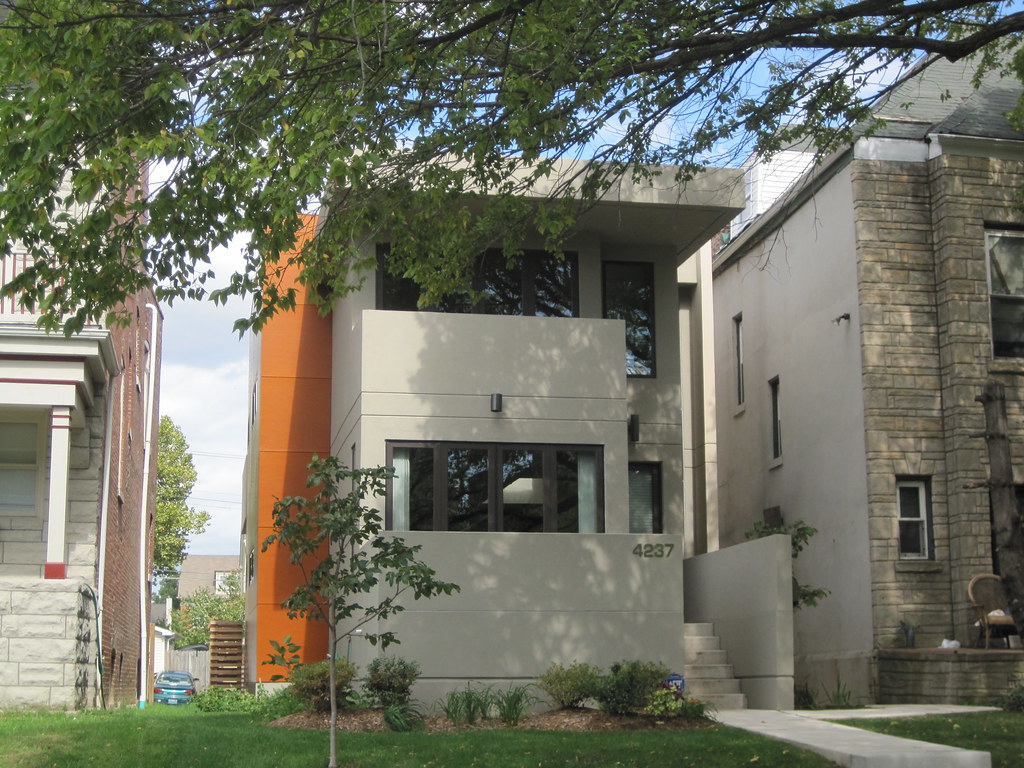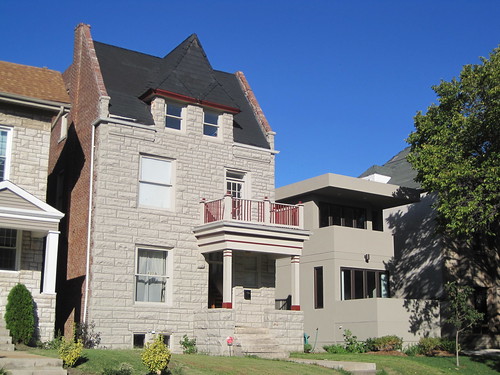 Strong lines, pronounced modern styling, a narrow, low form and neutral coloring (save the orange section) draw one's eyes to the house at 4237 McPherson Avenue in the Central West End. Inside, spaces flow into each other, and the compact front elevation dissolves into a voluminous open floor plan. This modern house, built last year, is like few other in the city.
Strong lines, pronounced modern styling, a narrow, low form and neutral coloring (save the orange section) draw one's eyes to the house at 4237 McPherson Avenue in the Central West End. Inside, spaces flow into each other, and the compact front elevation dissolves into a voluminous open floor plan. This modern house, built last year, is like few other in the city. While the modern design is worthy of our consideration alone, the siting opens all sorts of possibilities -- and questions for residents of of historic districts. See, the house is not one of a row of new houses, like those found in the old Gaslight Square two blocks to the north. See, 4237 McPherson fits in between two historic revival-style homes. That siting is deliberate.
While the modern design is worthy of our consideration alone, the siting opens all sorts of possibilities -- and questions for residents of of historic districts. See, the house is not one of a row of new houses, like those found in the old Gaslight Square two blocks to the north. See, 4237 McPherson fits in between two historic revival-style homes. That siting is deliberate.Anthony Robinson designed and developed this house, and is planning to build more on blocks in the eastern end of the Central West End. Nicknamed the "Robinson," the architect's contemporary town house primarily will fill gaps in parts of the Central West End that have seen substantial building loss. The "Robinson" offers a fresh way to introduce a new house into historic context.
Perhaps these houses aren't totally fresh; modernists experimented with slipping streamlined designs into the city in the twentieth century. The commercial and apartment architecture of Lindell Boulevard between Grand and Kingshighway contains many examples of minimalist, geometric design smack-dab next to ornament-heavy mansions and apartment buildings. That mix works, but it's not widespread in St. Louis. Anthony Robinson comes nearly fifty years later doing the same in the Central West End's side streets. His designs are new, but there is a fine precedent for his work.
 Robinson's first realized modern home design is located across the street from the house at 4237 McPherson. Built a few years earlier, this home shares much in common with the house across the street. Still, there are key differences. There is a projecting vertical pier next to the entrance, that rises up through the roof line. The second floor porch is cantilevered, not built over the first floor.
Robinson's first realized modern home design is located across the street from the house at 4237 McPherson. Built a few years earlier, this home shares much in common with the house across the street. Still, there are key differences. There is a projecting vertical pier next to the entrance, that rises up through the roof line. The second floor porch is cantilevered, not built over the first floor.Both houses finely balance the emphasis on height the narrow form brings with horizontal lines reminiscent of the Prairie School. However, these houses break from even the infill tradition on this block. The 4200 block of McPherson has seen a lot of loss and some rebuilding in the last 15 years. There are a number of Italianate-inspired townhouses on the block built by the Pyramid Companies in the 1990s. Just as Robinson's distinctive design has a signature look, Pyramid's townhouses are readily identifiable as that company's work.
 Many residents of historic districts across the city would probably rather see a Pyramid -- or something similar -- than a Robinson next door to their historic home. Most of our city's local historic district ordinances mandate attempts at architectural imitation and curtail original design. A "model example" is required in many cases, although often designs proposed borrow freely across "model examples" for hybrid designs. The result of these ordinances has been some very strong replica houses and a whole lot of really weak ones. The Pyramid houses are fairly simple, but they don't really resemble any houses built in St. Louis during the 19th and early 20th century.
Many residents of historic districts across the city would probably rather see a Pyramid -- or something similar -- than a Robinson next door to their historic home. Most of our city's local historic district ordinances mandate attempts at architectural imitation and curtail original design. A "model example" is required in many cases, although often designs proposed borrow freely across "model examples" for hybrid designs. The result of these ordinances has been some very strong replica houses and a whole lot of really weak ones. The Pyramid houses are fairly simple, but they don't really resemble any houses built in St. Louis during the 19th and early 20th century.The 4200 block of McPherson, however, is located in the Central West End local historic district. The Central West End historic district's standards, which date to 1974 and were written by Donald Royse and Carolyn Hewes Toft, expressly encourage quality contemporary architecture while discouraging historically imitative design. As we can see, both types of design have been built under those standards.
Attempts at historicization of new housing often have a negative impact in a historic district, because the new houses offer mongrel specimens of historical styles found in the neighborhood. One of the biggest problems is the replication of historical elements using cheap modern materials and factory-ordered pieces. Improvisation was the lifeblood of builders in our past, and new "historic" homes don't carry that tradition forward. Houses like the "Robinson" do.
Future local historic districts in the city have the chance to allow some design flexibility. In areas of St. Louis where there is a lot of vacant land, allowing truly original design in historic districts is logical. The truth about local historic districts under St. Louis preservation law is that citizens can adopt a wide range of design standards, from minimal to thorough. The aspirations of today's architects and builders can even be accommodated.





10 comments:
Just a note: Mr. Robinson is not an architect.
Thanks for highlighting the trends of infill in our city. Having traveled extensively throughout the country, I've made two observations:
1) Our historic residential architecture is among the very best in the country. We easily trump at least 90% of the country with our historic building stock.
2) Our new construction (with a few exceptions) is among the worst.
Cities like Cleveland, Philly and Milwaukee (not to mention Chicago, NYC) have embraced sleek, modern residential styles while St. Louis developers have clung to boring, "safe" imitations that insult St. Louis' rich legacy as a metropolis of extraordinary architectural standards.
I hope contemporary designs such as the Robinson, EcoUrban Homes, and a smattering of other innovative styles prevail over the schlocky faux-historic crap that dots otherwise handsome neighborhoods across our city. A funky mix of styles, materials and ages do not detract from the built environment, but rather enhance it.
Not only would I love to have a "Robinson" next to my historic home, I would love to own one! That is a beautiful home and fits in well with the historic properties adjacent to it. Much better than the Pyramid built homes if you ask me.
Robinson.
We have no unique new construction, except the few like these.
Anonymous,
Who cares if he's an architect or not if he designs cool houses?
I noticed this house the other day as I was on McPherson visiting a friend. I like the style, but the scale is not quite right with the other houses on the block. Mr. Robinson, Architect or not, has forward looking style, but I think the Garcia House by Mike Killeen on Miami is a better example: http://www.killeenstudio.com/Garcia-Miami.php
Chris said: "Who cares if he's an architect or not if he designs cool houses?"
How about those who spent years in an accredited architecture program, served years of internship servitude, passed a series of rigorous and expensive exams, are required to take continuing education courses every year and are held to a higher legal and financial liability for their effort? It is not only expensive to become but to BE an architect and that is a distinction that should not be bandied about -- even if inadvertently -- by those or about those who haven't earned it. The title Architect has a legal definition and is rightfully a protected title and there are legal penalties for misuse.
Can you tell I am a licensed architect?
Look, many jurisdictions do not require an architect to design single-family dwellings so Mr. Robinson has every right to draw and have built anything he likes. As a matter of fact, I personally like his designs and encourage progressive modern design at every turn. It just bore correcting since the post above says "Architect Anthony Robinson." In this instance he did not misrepresent himself (though perhaps to Mr. Allen he did) but in the interest of integrity it must be corrected so as not to mislead anyone seeking him out for services for which he is not qualified. A talented residential designer for sure, but an architect he is not.
Architect or no architect I am pretty sure that Michael was primarily discussing the obsurd restrictions to "alternative" modern design within historic districts. While playing historic preservationist and architect is key to keeping the the existing historic fabric of these neighborhoods it is an outright insult to the craftspeople that built them 100+ years ago when such horrid "mock historic" buildings are the only thing cultural resources and some older historic district standards plan on accepting! Bring on quality modern construction!
You are right, ezbngreen. Whether or not Mr. Robinson is an architect is not Michael's point -- it's mine. My issue is that it's intellectually dishonest to refer to him as an architect when, in fact, he is not. The nuance is oft understandably misunderstood by laymen but Michael (especially when gently reminded) has an obligation (at least to his reputation) to correct the mistake. I like Michael and respect his work on behalf of our community and the built environment but it leaves me questioning his accuracy in general when this stands uncorrected.
That said, the more high-caliber modern design, the better. I am glad to hear people clamoring for more thoughtful design (modern or more traditional) in our built environment -- whether in a historic district or not. One need only look as far as Kansas City, MO to see how we fall short in contemporary modern infill int he context of a historic midwestern city. They have been getting it done there with fervor and I would like to figure out why we (and I look at the development community) can't seem to go in that direction. Is it a matter of basic community values or just a perceived lack of market?
Mr. Robinson needs to be applauded as much for being a developer willing to work against the proverbial stream as for being a contemporary designer.
Made the change.
Post a Comment